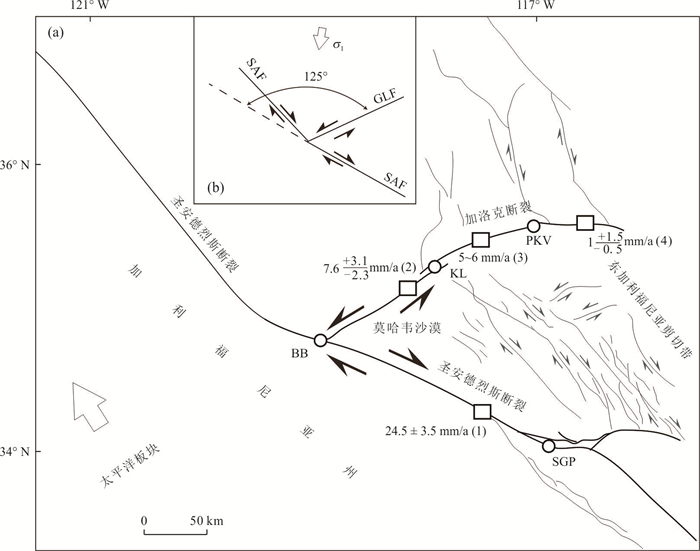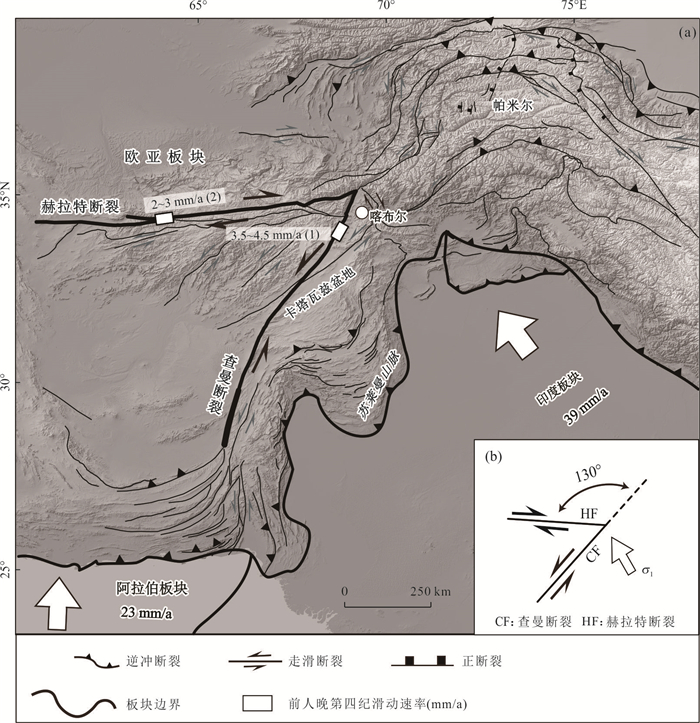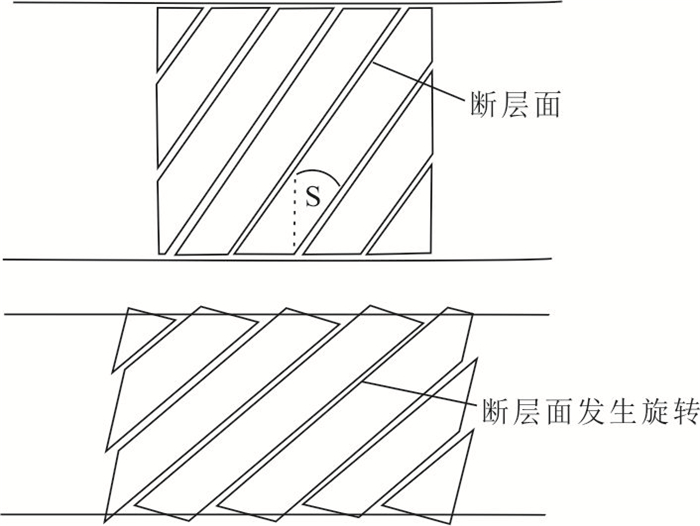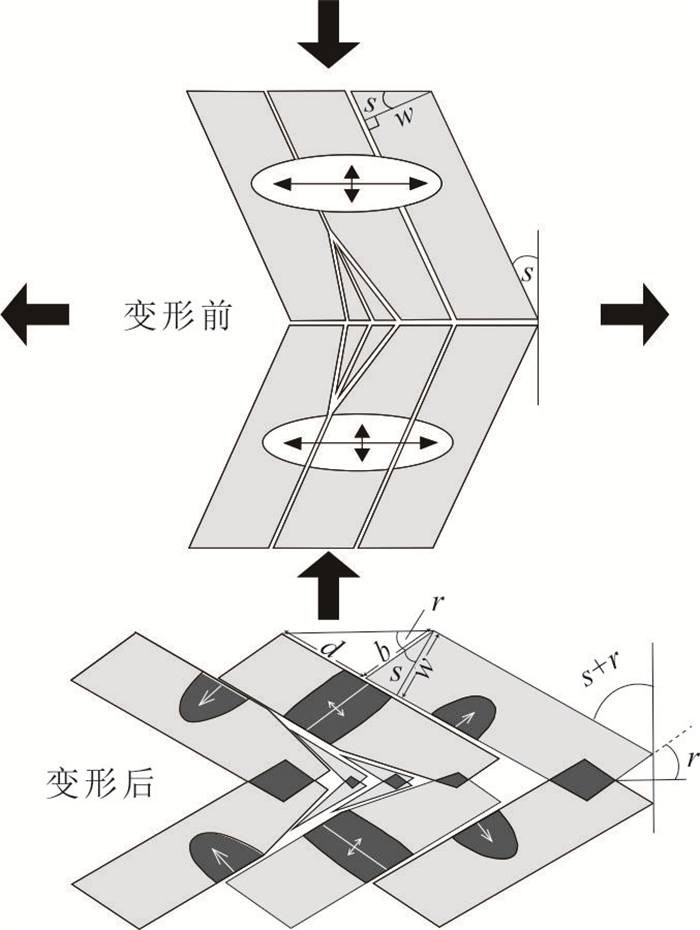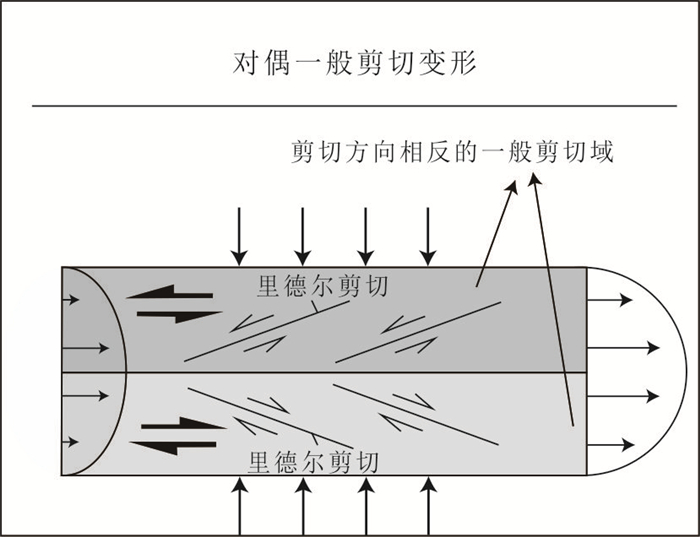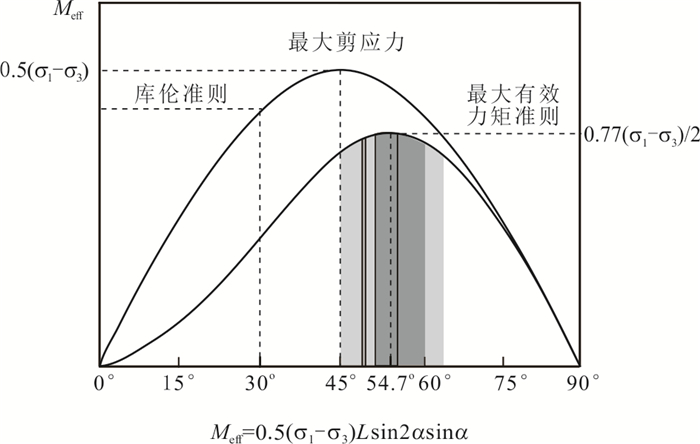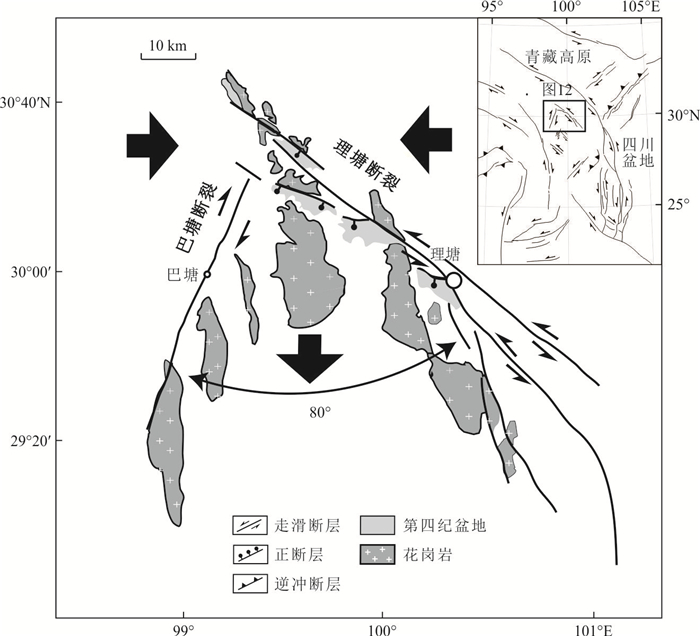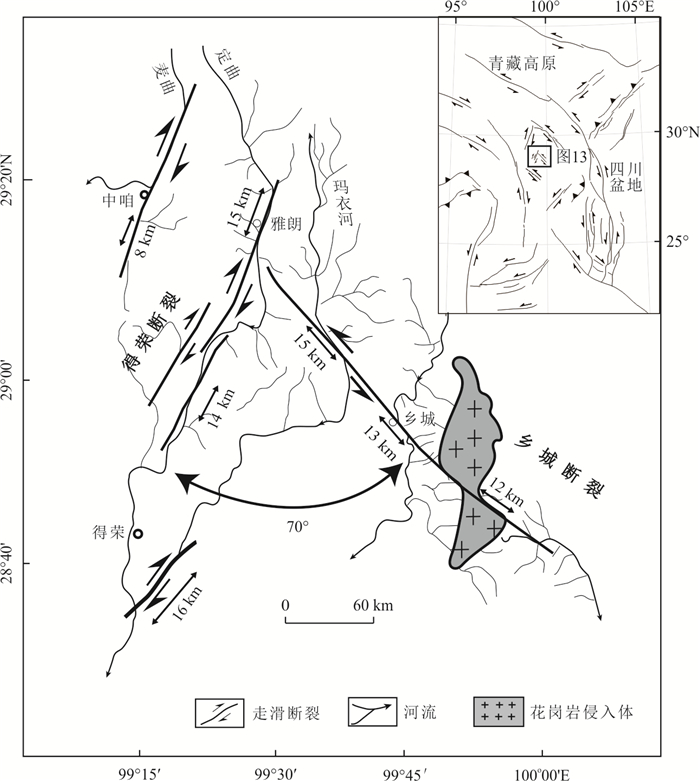V-Shaped Conjugate Strike-Slip Faults: Characteristics, Formation Mechanisms and Implications for the Late Cenozoic Deformation in the Southeastern Tibetan Plateau
-
摘要: “V”型共轭走滑断裂是指共轭角为钝角的共轭走滑断裂,其“V”型开口方向为锐角且指示最大拉伸方向.前人开展了大量关于“V”型共轭走滑断裂发育背景及动力学机制的研究,但是目前未有针对“V”型共轭断裂几何学、运动学有关的综述.归纳已有“V”型共轭走滑断裂的几何学、运动学特征,总结现存的“V”型共轭走滑断裂的动力学机制,并选取青藏高原东南缘“V”型共轭走滑断裂,进行实例分析.分布于美国西部、欧亚板块中西部和西藏中部的“V”型共轭走滑断裂特征揭示共轭角大小与断裂滑动速率及断裂长度均呈负相关关系.“V”型共轭走滑断裂的成因主要有:(1)断裂剪切面的后期旋转,(2)断裂形成于先存构造薄弱带,(3)断裂遵循对偶一般剪切模型,(4)断裂遵守最大有效力矩法则.基于地球物理数据、地形高差对比以及几何特征的分析,认为青藏高原东南缘川滇块体内部的巴塘-理塘共轭走滑断裂和得荣-乡城共轭走滑断裂的成因机制符合对偶一般剪切模型中的重力扩展,这为理解青藏高原东南缘下地壳连续变形的动力学机制提供了重要启示.Abstract: The V-shaped conjugate strike-slip fault system is defined as strike-slip faults with obtuse conjugate angles, whose opening side has an acute angle between the V-shaped faults, pointing to the direction of maximum extension. Previous studies on V-shaped conjugate strike-slip faults mostly focused on their development background and associated dynamic mechanisms. However, few literatures exist to comprehensively review the geometry and kinematics of V-shaped conjugate strike-slip faults. Here, we firstly summarize previous findings on the geometry, kinematic characteristics and formation mechanisms of existing V-shaped conjugate strike-slip faults, and then select the V-shaped conjugate strike-slip faults in the southeastern Tibetan Plateau for a case analysis. The characteristics of V-shaped conjugate strike-slip faults in the western United States, central and western Eurasian plate and central Tibet show a negative relation among conjugate angles and corresponding fault slip rates and fault lengths. The four formation mechanisms of the V-shaped conjugate strike-slip faults are 1) the fault planes experienced rotation after their formation, 2) the faults were reactivated along preexisting structurally weak zones, 3) the faults followed the paired general shear model and 4) the fault evolved according to the maximum-effective-moment criterion. Integrating analyses of geophysical data, elevation difference and geometric characteristics, we infer that the development of V-shaped conjugate strike-slip faults (Batang-Litang and Derong-Xiangcheng faults) in the Chuan-Dian block in the southeastern Tibetan Plateau, is consistent with gravitational spreading of the Tibetan lithosphere under the paired general shear model. This provides important insights for understanding the continuum crustal deformation in the southeastern Tibetan Plateau.
-
图 1 纯剪切共轭走滑断裂模型(据Fossen,2016修改)
黑色实线表示断裂面;黑虚线表示主应力方向;σ1为最大主应力方向;σ2为中间主应力方向;σ3为最小主应力方向;θ0为剪切角
Fig. 1. Pure shear conjugate model for the formation of strike-slip faults (modified form Fossen, 2016)
图 3 圣安德烈斯-加洛克共轭走滑断裂示意图(a)及共轭角示意图(b)(改自Hatem and Dolan, 2018)
BB. “大弯曲”;GLF. 加洛克断裂;KL. Koehn湖;PKV. Pilot Knob山谷;SAF. 圣安德烈斯断裂;SGP. 圣戈尔戈尼奥山口;白色方框为前人晚第四纪滑动速率(mm/a)位置:(1)Cooke and Dair(2011);McGill et al.(2013).(2)McGill et al.(2009).(3)McGill and Sieh(1993);Ganev et al.(2012);Crane(2014);Dolan et al.(2016).(4)Crane(2014)
Fig. 3. Sketch map of the San Andreas-Garlock conjugate strike-slip fault system (a) and the conjugate angle (b) (modified from Hatem and Dolan, 2018)
图 4 安纳托利亚块体及邻区主要构造单元(改自Barka and Kadinsky-Cade, 1988)
a.北安纳托利亚断裂和东安纳托利亚断裂交汇在卡尔勒奥瓦三联点(K),西侧为卡尔勒奥瓦盆地(KB.Karliova Basin).白色方框为前人晚第四纪滑动速率(mm/a)位置:(1)Kozacı et al.(2009);(2)Cetin et al.(2003);b.北-东安纳托利亚共轭走滑断裂共轭角为135°.EAF.东安纳托利亚断裂;NAF.北安纳托利亚断裂;T.塔绍瓦地区
Fig. 4. Major tectonic elements of Anatolian block and adjacent area(modified form Barka and Kadinsky-Cade, 1988)
图 5 欧亚板块中部区域构造图(改自Shnizai et al., 2020)
a.赫拉特-查曼共轭走滑断裂图;白色方框为前人晚第四纪滑动速率(mm/a)位置:(1)Mohadjer et al.(2016);(2)Shnizai et al.(2020). b.赫拉特-查曼共轭断裂共轭角大小
Fig. 5. Regional tectonic map of the central Eurasian plate (modified from Shnizai et al., 2020)
图 6 西藏中部区域构造图(改自Taylor et al., 2003)
a.西藏中部共轭走滑断裂系;b.共轭断裂系共轭角大小. ①布木错断裂;②拉木错-纳屋错断裂;③日干配错断裂;④格仁错断裂;⑤懂错断裂;⑥崩错断裂.(1)刘富财等(2022);(2)Shi et al.(2014);Wang et al.(2021);(3)Hollingsworth et al.(2010);Li et al.(2022).白色方框为前人晚第四纪滑动速率(mm/a)位置
Fig. 6. Regional tectonic map of the central Tibet (modified from Taylor et al., 2003)
图 8 断层面的旋转(改自Freund, 1970).
Fig. 8. The rotation of fault planes (modified form Freund, 1970)
图 9 断裂面旋转之后的几何模型(改自Freund,1970)
r.旋转角;d.位移;w.相邻断裂之间的宽度;s.剪切角
Fig. 9. A geometrical model of the restoration of the strike-slip faults (modified from Freund, 1970)
图 10 对偶一般剪切模型(改自Yin and Taylor, 2011)
Fig. 10. Paired General Shear deformation model (modified from Yin and Taylor, 2011)
图 11 库伦准则和最大有效力矩准则(改自Zheng et al., 2011)
σ1-σ3. 材料的屈服强度;$ \alpha $. σ1和剪切面之间的角度;L. 单位长度;灰色的区域显示了从实验到野外观测测得的数据;深灰色的区域涵盖了Gómez-Rivas and Carreras(2008)实验中提供的数据;4个垂直线代表Kurz and Northrup(2008)在自然界中测量的4个共轭角
Fig. 11. Coulomb criterion and the maximum effective moment criterion (modified from Zheng et al., 2011)
图 12 巴塘-理塘共轭走滑断裂示意图(改自Su et al., 2012)
巴塘-理塘断裂面最大拉伸方向角度为80°,共轭角大小为100°
Fig. 12. Sketch map of the Batang-Litang conjugate strike-slip fault system (modified from Su et al., 2012)
图 13 得荣-乡城断裂的地貌位错图(改自Su et al., 2012)
得荣-乡城断裂面最大拉伸方向角度为70°,共轭角大小为110°
Fig. 13. Geomorphic displacement along the Derong-Xiangcheng conjugate strike-slip faults (modified from Su et al., 2012)
-
Aktug, B., Ozener, H., Dogru, A., et al., 2016. Slip Rates and Seismic Potential on the East Anatolian Fault System Using an Improved GPS Velocity Field. Journal of Geodynamics, 94/95: 1-12. https://doi.org/10.1016/j.jog.2016.01.001 Ambraseys, N. N., 1970. Some Characteristic Features of the Anatolian Fault Zone. Tectonophysics, 9(2/3): 143-165. https://doi.org/10.1016/0040-1951(70)90014-4 Anderson, T. B., 1964. Kink-Bands and Related Geological Structures. Nature, 202(4929): 272-274. https://doi.org/10.1038/202272a0 Andrew, J. E., Walker, J. D., Monastero, F. C., 2015. Evolution of the Central Garlock Fault Zone, California: A Major Sinistral Fault Embedded in a Dextral Plate Margin. Geological Society of America Bulletin, 127(1-2): 227-249. https://doi.org/10.1130/b31027.1 Arpat, E., Şaroglu, F., 1972. The East Anatolian Fault System: Thoughts on Its Development. Bulletin of the Mineral Research Exploration, 78(78): 1-12. Barka, A. A., Hancock, P. L., 1984. Neotectonic Deformation Patterns in the Convex-Northwards Arc of the North Anatolian Fault Zone. Geological Society, London, Special Publications, 17(1): 763-774. https://doi.org/10.1144/gsl.sp.1984.017.01.61 Barka, A. A., Kadinsky-Cade, K., 1988. Strike-Slip Fault Geometry in Turkey and Its Influence on Earthquake Activity. Tectonics, 7(3): 663-684. https://doi.org/10.1029/TC007i003p00663 Bian, S., Gong, J., Zuza, A. V., et al., 2020. Late Pliocene Onset of the Cona Rift, Eastern Himalaya, Confirms Eastward Propagation of Extension in Himalayan-Tibetan Orogen. Earth and Planetary Science Letters, 544: 116383. https://doi.org/10.1016/j.epsl.2020.116383 Boyd, O. S., Mueller, C. S., Rukstales, K. S., 2007. Preliminary Earthquake Hazard Map of Afghanistan. US Geological Survey Open-File Report, 1137. Burbank, D. W., Whistler, D. P., 1987. Temporally Constrained Tectonic Rotations Derived from Magnetostratigiraphic Data: Implications for the Initiation of the Garlock Fault, California. Geology, 15(12): 1172. https://doi.org/10.1130/0091-7613(1987)151172:tctrdf>2.0.co;2 doi: 10.1130/0091-7613(1987)151172:tctrdf>2.0.co;2 Byerlee, J., 1978. Friction of Rocks. Pure and Applied Geophysics PAGEOPH, 116(4-5): 615-626. https://doi.org/10.1007/bf00876528 Catchings, R. D., 2002. High-Resolution Seismic Velocities and Shallow Structure of the San Andreas Fault Zone at Middle Mountain, Parkfield, California. Bulletin of the Seismological Society of America, 92(6): 2493-2503. https://doi.org/10.1785/0120010263 Cetin, H., Güneyli, H., Mayer, L., 2003. Paleoseismology of the Palu-Lake Hazar Segment of the East Anatolian Fault Zone, Turkey. Tectonophysics, 374(3/4): 163-197. https://doi.org/10.1016/j.tecto.2003.08.003 Chen, G. F., Bartholomew, M., Liu, D. M., et al., 2022. Paleo-Earthquakes along the Zheduotang Fault, Xianshuihe Fault System, Eastern Tibet: Implications for Seismic Hazard Evaluation. Journal of Earth Science, 33(5): 1233-1245. https://doi.org/10.1007/s12583-022-1687-0 Chen, M., Huang, H., Yao, H., et al., 2014. Low Wave Speed Zones in the Crust beneath SE Tibet Revealed by Ambient Noise Adjoint Tomography. Geophysical Research Letters, 41(2): 334-340. https://doi.org/10.1002/2013gl058476 Chevalier, M. L., Leloup, P. H., Replumaz, A., et al., 2016. Tectonic-Geomorphology of the Litang Fault System, SE Tibetan Plateau, and Implication for Regional Seismic Hazard. Tectonophysics, 682: 278-292. https://doi.org/10.1016/j.tecto.2016.05.039 Chorowicz, J., Dhont, D., Gündoğdu, N., 1999. Neotectonics in the Eastern North Anatolian Fault Region (Turkey) Advocates Crustal Extension: Mapping from SARERS Imagery and Digital Elevation Model. Journal of Structural Geology, 21(5): 511-532. https://doi.org/10.1016/S0191-8141(99)00022-X Clark, M. K., House, M. A., Royden, L. H., et al., 2005. Late Cenozoic Uplift of Southeastern Tibet. Geology, 33(6): 525. https://doi.org/10.1130/g21265.1 Cloos, E., 1955. Experimental Analysis of Fracture Patterns. Geological Society of America Bulletin, 66(3): 241. https://doi.org/10.1130/0016-7606(1955)66[241:eaofp]2.0.co;2 Cooke, M. L., Dair, L. C., 2011. Simulating the Recent Evolution of the Southern Big Bend of the San Andreas Fault, Southern California. Journal of Geophysical Research: Solid Earth, 116(B4): B04405. https://doi.org/10.1029/2010JB007835 Crane, T.M., 2014. Qualitative Comparison of Offset Surfaces between the Central and Eastern Garlock Fault. Electronic Theses, Projects, and Dissertations, 119. Davis, G. A., Burchfiel, B. C., 1973. Garlock Fault: An Intracontinental Transform Structure, Southern California. Geological Society of America Bulletin, 84(4): 1407. https://doi.org/10.1130/0016-7606(1973)841407:gfaits>2.0.co;2 doi: 10.1130/0016-7606(1973)841407:gfaits>2.0.co;2 Dawson, T. E., McGill, S. F., Rockwell, T. K., 2003. Irregular Recurrence of Paleoearthquakes along the Central Garlock Fault near El Paso Peaks, California. Journal of Geophysical Research: Solid Earth, 108(B7): 2356. https://doi.org/10.1029/2001JB001744 Dickinson, W. R., Wernicke, B. P., 1997. Reconciliation of San Andreas Slip Discrepancy by a Combination of Interior Basin and Range Extension and Transrotation near the Coast. Geology, 25(7): 663. https://doi.org/10.1130/0091-7613(1997)0250663:rosasd>2.3.co;2 doi: 10.1130/0091-7613(1997)0250663:rosasd>2.3.co;2 Dixon, T. H., Xie, S., 2018. A Kinematic Model for the Evolution of the Eastern California Shear Zone and Garlock Fault, Mojave Desert, California. Earth and Planetary Science Letters, 494: 60-68. https://doi.org/10.1016/j.epsl.2018.04.050 Dolan, J. F., McAuliffe, L. J., Rhodes, E. J., et al., 2016. Extreme Multi-Millennial Slip Rate Variations on the Garlock Fault, California: Strain Super-Cycles, Potentially Time-Variable Fault Strength, and Implications for System-Level Earthquake Occurrence. Earth and Planetary Science Letters, 446: 123-136. https://doi.org/10.1016/j.epsl.2016.04.011 DuRoss, C.B., Gold, R.D., Dawson, T.E., et al., 2020. Surface Displacement Distributions for the July 2019 Ridgecrest, California, Earthquake Ruptures. Bulletin of the Seismological Society of America, 110(4): 1400-1418. https://doi.org/10.1785/0120200058 Fialko, Y., 2006. Interseismic Strain Accumulation and the Earthquake Potential on the Southern San Andreas Fault System. Nature, 441(7096): 968-971. https://doi.org/10.1038/nature04797 Fialko, Y., Jin, Z. Y., 2021. Simple Shear Origin of the Cross-Faults Ruptured in the 2019 Ridgecrest Earthquake Sequence. Nature Geoscience, 14(7): 513-518. https://doi.org/10.1038/s41561-021-00758-5 Fossen, H., 2016. Structural Geology. Cambridge University Press, Cambridge. Freund, R., 1970. Rotation of Strike Slip Faults in Sistan, Southeast Iran. The Journal of Geology, 78(2): 188-200. https://doi.org/10.1086/627500 Gan, W. J., Zhang, P. Z., Shen, Z. K., et al., 2007. Present-Day Crustal Motion within the Tibetan Plateau Inferred from GPS Measurements. Journal of Geophysical Research: Solid Earth, 112(B8): B08416. https://doi.org/10.1029/2005jb004120 Ganev, P. N., Dolan, J. F., McGill, S. F., et al., 2012. Constancy of Geologic Slip Rate along the Central Garlock Fault: Implications for Strain Accumulation and Release in Southern California. Geophysical Journal International, 190(2): 745-760. https://doi.org/10.1111/j.1365-246X.2012.05494.x Garthwaite, M. C., Wang, H., Wright, T. J., 2013. Broadscale Interseismic Deformation and Fault Slip Rates in the Central Tibetan Plateau Observed Using InSAR. Journal of Geophysical Research: Solid Earth, 118(9): 5071-5083. https://doi.org/10.1002/jgrb.50348 George, I. S., 1962. Large Lateral Displacement on Garlock Fault, Califonia, as Measured from Offset Dike Swarm. AAPG Bulletin, 46. https://doi.org/10.1306/bc74375f-16be-11d7-8645000102c1865d Gómez-Rivas, E., Carreras, J., 2008. Localization of Deformation in Ductile and Anisotropic Media: Field, Experimental and Numerical Study (Dissertation). Autonomous University of Barcelona, Spain. Hatem, A. E., Dolan, J. F., 2018. A Model for the Initiation, Evolution, and Controls on Seismic Behavior of the Garlock Fault, California. Geochemistry, Geophysics, Geosystems, 19(7): 2166-2178. https://doi.org/10.1029/2017GC007349 He, X., Zhao, L. F., Xie, X. B., et al., 2021. Weak Crust in Southeast Tibetan Plateau Revealed by Lg-Wave Attenuation Tomography: Implications for Crustal Material Escape. Journal of Geophysical Research: Solid Earth, 126(3): e2020JB020748. https://doi.org/10.1029/2020JB020748 Hill, M. L., Dibblee, T. W., 1953. San Andreas, Garlock, and Big Pine Faults, California. Geological Society of America Bulletin, 64(4): 443. https://doi.org/10.1130/0016-7606(1953)64[443:sagabp]2.0.co;2 Hollingsworth, J., Wernicke, B. P., Ding, L., 2010. Fault Slip-Rate Estimate for the Right-Lateral Beng Co Strike-Slip Fault, Based on Quaternary Dating of Displaced Paleo-Lake Shorelines. AGU Fall Meeting Abstracts. Hubert-Ferrari, A., Armijo, R., King, G., et al., 2002. Morphology, Displacement, and Slip Rates along the North Anatolian Fault, Turkey. Journal of Geophysical Research: Solid Earth, 107(B10): ETG9-1. https://doi.org/10.1029/2001jb000393 Jaeger, J. C., Cook, N., 1979. Fundamentalsof Rock Mechanics. Third Edition. Science Paperbacks, 9(3): 251-252. Ketin, İ., 1969. Kuzey Anadolu Fayi Hakkinda(On the North Anatolian Fault). MTA Dergisi, 72: 1-27. Khalifa, A., Çakir, Z., Owen, L., et al., 2018. Morphotectonic Analysis of the East Anatolian Fault, Turkey. Turkish Journal of Earth Sciences, 27(2): 110. https://doi.org/10.3906/yer-1707-16 Köküm, M., İnceöz, M., 2018. Structural Analysis of the Northern Part of the East Anatolian Fault System. Journal of Structural Geology, 114: 55-63. https://doi.org/10.1016/j.jsg.2018.06.016 Kozacı, Ö., Dolan, J. F., Finkel, R. C., 2009. A Late Holocene Slip Rate for the Central North Anatolian Fault, at Tahtaköprü, Turkey, from Cosmogenic 10Be Geochronology: Implications for Fault Loading and Strain Release Rates. Journal of Geophysical Research: Solid Earth, 114(B1): B01405. https://doi.org/10.1029/2008JB005760 Kurz, G. A., Northrup, C. J., 2008. Structural Analysis of Mylonitic Rocks in the Cougar Creek Complex, Oregon-Idaho Using the Porphyroclast Hyperbolic Distribution Method, and Potential Use of SC'-Type Extensional Shear Bands as Quantitative Vorticity Indicators. Journal of Structural Geology, 30(8): 1005-1012. https://doi.org/10.1016/j.jsg.2008.04.003 Lawrence, R.D., Khan, S.H., Nakata, T., 1992. Chaman Fault, Pakistan-Afghanistan. Ann. Tectonicae, 6, 196-223. Leedal, G. P., Walker, G. P. L., 1954. Tear Faults in the Barnesmore Area, Donegal. Geological Magazine, 91(2): 116-120. https://doi.org/10.1017/s0016756800064980 Li, H.B., Yang, J.S., Xu, Z.Q., et al., 2006. The Constraint of the Altyn Tagh Fault System to the Growth and Rise of the Northern Tibetan Plateau. Earth Science Frontiers, 13(4): 59-79 (in Chinese with English abstract). Li, K., Tapponnier, P., Xu, X. W., et al., 2022. Holocene Slip Rate along the Beng Co Fault and Dextral Strike-Slip Extrusion of Central Eastern Tibet. Tectonics, 41(8): e2022TC007230. https://doi.org/10.1029/2022TC007230 Li, Y. S., Tian, Y. F., Yu, C., et al., 2020. Present-Day Interseismic Deformation Characteristics of the Beng Co-Dongqiao Conjugate Fault System in Central Tibet: Implications from InSAR Observations. Geophysical Journal International, 221(1): 492-503. https://doi.org/10.1093/gji/ggaa014 Liang, C., Ampuero, J. P., Pino Muñoz, D., 2021. Deep Ductile Shear Zone Facilitates Near-Orthogonal Strike-Slip Faulting in a Thin Brittle Lithosphere. Geophysical Research Letters, 48(2): e2020GL090744. https://doi.org/10.1029/2020GL090744 Liu, F.C., Pan, J.W., Li, H.B., et al., 2022. Characteristics of Quaternary Activities along the Piganpei Co Fault and Seismogenic Structure of the July 23, 2020 MW6.4 Nima Earthquake, Central Tibet. Acta Geoscientica Sinica, 43(2): 173-188 (in Chinese with English abstract). Loomis, D. P., Burbank, D. W., 1988. The Stratigraphic Evolution of the El Paso Basin, Southern California: Implications for the Miocene Development of the Garlock Fault and Uplift of the Sierra Nevada. Geological Society of America Bulletin, 100(1): 12-28. https://doi.org/10.1130/0016-7606(1988)1000012:tseote>2.3.co;2 doi: 10.1130/0016-7606(1988)1000012:tseote>2.3.co;2 Loveless, J. P., Meade, B. J., 2011. Stress Modulation on the San Andreas Fault by Interseismic Fault System Interactions. Geology, 39(11): 1035-1038. https://doi.org/10.1130/g32215.1 McGill, S. F., Owen, L. A., Weldon, R. J. Ⅱ, et al., 2013. Latest Pleistocene and Holocene Slip Rate for the San Bernardino Strand of the San Andreas Fault, Plunge Creek, Southern California: Implications for Strain Partitioning within the Southern San Andreas Fault System for the last ~35 k. y. Geological Society of America Bulletin, 125(1-2): 48-72. https://doi.org/10.1130/b30647.1 McGill, S. F., Wells, S. G., Fortner, S. K., et al., 2009. Slip Rate of the Western Garlock Fault, at Clark Wash, near Lone Tree Canyon, Mojave Desert, California. Geological Society of America Bulletin, 121(3-4): 536-554. https://doi.org/10.1130/b26123.1 McGill, S., Sieh, K., 1993. Holocene Slip Rate of the Central Garlock Fault in Southeastern Searles Valley, California. Journal of Geophysical Research: Solid Earth, 98(B8): 14217-14231. https://doi.org/10.1029/93JB00442 Mohadjer, S., Alan Ehlers, T., Bendick, R., et al., 2016. A Quaternary Fault Database for Central Asia. Natural Hazards and Earth System Sciences, 16(2): 529-542. https://doi.org/10.5194/nhess-16-529-2016 Mohadjer, S., Bendick, R., Ischuk, A., et al., 2010. Partitioning of India-Eurasia Convergence in the Pamir-Hindu Kush from GPS Measurements. Geophysical Research Letters, 37(4): L04305. https://doi.org/10.1029/2009gl041737 Molnar, P., Dayem, K. E., 2010. Major Intracontinental Strike-Slip Faults and Contrasts in Lithospheric Strength. Geosphere, 6(4): 444-467. https://doi.org/10.1130/ges00519.1 Monastero, F. C., Sabin, A. E., Walker, J. D., 1997. Evidence for Post-Early Miocene Initiation of Movement on the Garlock Fault from Offset of the Cudahy Camp Formation, East-Central California. Geology, 25(3): 247. https://doi.org/10.1130/0091-7613(1997)0250247:efpemi>2.3.co;2 doi: 10.1130/0091-7613(1997)0250247:efpemi>2.3.co;2 Naylor, M., Mandl, G. T., Supesteijn, C., 1986. Fault Geometries in Basement-Induced Wrench Faulting under Different Initial Stress States. Journal of Structural Geology, 8(7): 737-752. https://doi.org/10.1016/0191-8141(86)90022-2 Norris, R. J., Toy, V. G., 2014. Continental Transforms: AView from the Alpine Fault. Journal of Structural Geology, 64: 3-31. https://doi.org/10.1016/j.jsg.2014.03.003 Pananont, P., Herman, M. W., Pornsopin, P., et al., 2017. Seismotectonics of the 2014 Chiang Rai, Thailand, Earthquake Sequence. Journal of Geophysical Research: Solid Earth, 122(8): 6367-6388. https://doi.org/10.1002/2017jb014085 Platt, J. P., Passchier, C. W., 2016. Zipper Junctions: aNew Approach to the Intersections of Conjugate Strike-Slip Faults. Geology, 44(10): 795-798. https://doi.org/10.1130/g38058.1 Platt, J. P., Vissers, R. L. M., 1980. Extensional Structures in Anisotropic Rocks. Journal of Structural Geology, 2(4): 397-410. https://doi.org/10.1016/0191-8141(80)90002-4 Ranalli, G., 1995. Rheology of the Earth. 2nded. Chanman and Hall, London. Ratschbacher, L., Frisch, W., Linzer, H. G., et al., 1991. Lateral Extrusion in the Eastern Alps, Part 2: Structural Analysis. Tectonics, 10(2): 257-271. https://doi.org/10.1029/90tc02623 Reid, A. J., Wilson, C. J. L., Phillips, D., et al., 2005. Mesozoic Cooling across the Yidun Arc, Central-Eastern Tibetan Plateau: A Reconna Issance 40Ar/39Ar Study. Tectonophysics, 398(1-2): 45-66. https://doi.org/10.1016/j.tecto.2005.01.002 Royden, L. H., Burchfiel, B. C., King, R. W., et al., 1997. Surface Deformation and Lower Crustal Flow in Eastern Tibet. Science, 276(5313): 788-790. https://doi.org/10.1126/science.276.5313.788 Ruleman, C. A., Crone, A. J., Machette, M. N., et al., 2007. Map and Database of Probable and Possible Quaternary Faults in Afghanistan. US Geological Survey Open-File Report, 1103(1). Şengör, A. M. C., Görür, N., Şaroğlu, F., 1985. Strike-Slip Faulting and Related Basin Formation in Zones of Tectonic Escape: Turkey as a Case Study. Strike-Slip Deformation, Basin Formation, and Sedimentation. SEPM (Society for Sedimentary Geology), 227-264. https://doi.org/10.2110/pec.85.37.0227 Şengör, A. M. C., Kidd, W. S. F., 1979. Post-Collisional Tectonics of the Turkish-Iranian Plateau and a Comparison with Tibet. Tectonophysics, 55(3/4): 361-376. https://doi.org/10.1016/0040-1951(79)90184-7 Shi, X. H., Kirby, E., Lu, H. J., et al., 2014. Holocene Slip Rate along the Gyaring Co Fault, Central Tibet. Geophysical Research Letters, 41(16): 5829-5837. https://doi.org/10.1002/2014gl060782 Shnizai, Z., Matsushi, Y., Tsutsumi, H., 2020. Late Pleistocene Slip Rate of the Chaman Fault Based on 10Be Exposure Dating of Offset Geomorphic Surfaces near Kabul, Afghanistan. Tectonophysics, 795: 228593. https://doi.org/10.1016/j.tecto.2020.228593 Su, Z., Wang, E., Furlong, K. P., et al., 2012. Young, Active Conjugate Strike-Slip Deformation in West Sichuan: Evidence for the Stress-Strain Pattern of the Southeastern Tibetan Plateau. International Geology Review, 54(9): 991-1012. https://doi.org/10.1080/00206814.2011.583491 Sylvester, A. G., 1988. Strike-Slip Faults. Geological Society of America Bulletin, 100(11): 1666-1703. https://doi.org/10.1130/0016-7606(1988)1001666:ssf>2.3.co;2 doi: 10.1130/0016-7606(1988)1001666:ssf>2.3.co;2 Tapponnier, P., Mattauer, M., Proust, F., et al., 1981. Mesozoic Ophiolites, Sutures, and Arge-Scale Tectonic Movements in Afghanistan. Earth and Planetary Science Letters, 52(2): 355-371. https://doi.org/10.1016/0012-821x(81)90189-8 Tapponnier, P., Peltzer, G., Armijo, R., 1986. On the Mechanics of the Collision between India and Asia. Geological Society, London, Special Publications, 19(1): 113-157. https://doi.org/10.1144/gsl.sp.1986.019.01.07 Tapponnier, P., Peltzer, G., Le Dain, A. Y., et al., 1982. Propagating Extrusion Tectonics in Asia: New Insights from Simple Experiments with Plasticine. Geology, 10(12): 611-616. https://doi.org/10.1130/0091-7613(1982)10611:petian>2.0.co;2 doi: 10.1130/0091-7613(1982)10611:petian>2.0.co;2 Tatar, O., Poyraz, F., Gürsoy, H., et al., 2012. Crustal Deformation and Kinematics of the Eastern Part of the North Anatolian Fault Zone (Turkey) from GPS Measurements. Tectonophysics, 518/519/520/521: 55-62. https://doi.org/10.1016/j.tecto.2011.11.010 Taylor, M., Peltzer, G., 2006. Current Slip Rates on Conjugate Strike-Slip Faults in Central Tibet Using Synthetic Aperture Radar Interferometry. Journal of Geophysical Research: Solid Earth, 111(B12): B12402. https://doi.org/10.1029/2005jb004014 Taylor, M., Yin, A., Ryerson, F. J., et al., 2003. Conjugate Strike-Slip Faulting along the Bangong-Nujiang Suture Zone Accommodates Coeval East-West Extension and North-South Shortening in the Interior of the Tibetan Plateau. Tectonics, 22(4): 1044. https://doi.org/10.1029/2002tc001361 Tchalenko, J. S., 1970. Similarities between Shear Zones of Different Magnitudes. Geological Society of America Bulletin, 81(6): 1625-1640. https://doi.org/10.1130/0016-7606(1970)81[1625:sbszod]2.0.co;2 Thatcher, W., Hill, D. P., 1991. Fault Orientations in Extensional and Conjugate Strike-Slip Environments and Their Implications. Geology, 19(11): 1116. https://doi.org/10.1130/0091-7613(1991)0191116:foieac>2.3.co;2 doi: 10.1130/0091-7613(1991)0191116:foieac>2.3.co;2 Walters, R. J., Parsons, B., Wright, T. J., 2014. Constraining Crustal Velocity Fields with InSAR for Eastern Turkey: Limits to the Block-Like Behavior of Eastern Anatolia. Journal of Geophysical Research: Solid Earth, 119(6): 5215-5234. https://doi.org/10.1002/2013JB010909 Wan, T.F., 1984. Discussion on the Shear Angle of Conjugate Fractures. Geological Review, 30(2): 106-113 (in Chinese with English abstract). Wang, D., Chang, H., Yin, G. M., et al., 2021. Spatial Changes in Late Quaternary Slip Rates along the Gyaring Co Fault: Implications for Strain Partitioning and Deformation Modes in Central Tibet. Tectonics, 40(5): e2020TC006110. https://doi.org/10.1029/2020TC006110 Wang, H., Wright, T. J., Liu-Zeng, J., et al., 2019. Strain Rate Distribution in South-Central Tibet from Two Decades of InSAR and GPS. Geophysical Research Letters, 46(10): 5170-5179. https://doi.org/10.1029/2019GL081916 Wang, Y. Z., Wang, E. N., Shen, Z. K., et al., 2008. GPS-Constrained Inversion of Present-Day Slip Rates along Major Faults of the Sichuan-Yunnan Region, China. Science in China Series D: Earth Sciences, 51(9): 1267-1283. https://doi.org/10.1007/s11430-008-0106-4 Wellman, H. W., 1954. Angle between the Principal Horizontal Stress and Transcurrent Faults. Geological Magazine, 91(5): 407-408. https://doi.org/10.1017/s001675680006581x White, S. H., Burrows, S. E., Carreras, J., et al., 1980. On Mylonites in Ductile Shear Zones. Journal of Structural Geology, 2(1/2): 175-187. https://doi.org/10.1016/0191-8141(80)90048-6 Wilcox, R. E., Harding, T. T., Seely, D., 1973. Basic Wrench Tectonics. AAPG Bulletin, 57: 74-96. https://doi.org/10.1306/819a424a-16c5-11d7-8645000102c1865d Wilson, C. J. L., Harrowfield, M. J., Reid, A. J., 2006. Brittle Modification of Triassic Architecture in Eastern Tibet: Implications for the Construction of the Cenozoic Plateau. Journal of Asian Earth Sciences, 27(3): 341-357. https://doi.org/10.1016/j.jseaes.2005.04.004 Wright, T., Parsons, B., Fielding, E., 2001. Measurement of Interseismic Strain Accumulation across the North Anatolian Fault by Satellite Radar Interferometry. Geophysical Research Letters, 28(10): 2117-2120. https://doi.org/10.1029/2000gl012850 Wu, G.H., Ma, B.S., Han, J.F., et al., 2021. Origin and Growth Mechanisms of Strike-Slip Faults in the Central Tarim Cratonic Basin, NW China. Petroleum Exploration and Development, 48(3): 510-520 (in Chinese with English abstract). Xu, L. L., Rondenay, S., van der Hilst, R. D., 2007. Structure of the Crust beneath the Southeastern Tibetan Plateau from Teleseismic Receiver Functions. Physics of the Earth and Planetary Interiors, 165(3/4): 176-193. https://doi.org/10.1016/j.pepi.2007.09.002 Xu, X. W., Wen, X. Z., Yu, G. H., et al., 2005. Average Slip Rate, Earthquake Rupturing Segmentation and Recurrence Behavior on the Litang Fault Zone, Western Sichuan Province, China. Science in China Series D: Earth Sciences, 48(8): 1183-1196. https://doi.org/10.1360/04yd0072 Xu, X., Wen, X., Zheng, R., et al., 2003. Pattern of Latest Tectonic Motion and Its Dynamics for Active Blocks in Sichuan-Yunnan Region, China. Science in China Series D: Earth Sciences, 46(2): 210-226. doi. org/10.1360/03dz0017 Xu, Z.Q., Li, H.B., Tang, Z.M., et al., 2011. The Transformation of the Terrain Structures of the Tibet Plateau through Large-Scale Strike-Slip Faults. Acta Petrologica Sinica, 27(11): 3157-3170 (in Chinese with English abstract). Yang, W., Liu, X., Chen, Z., et al., 2022. Asthenosphere Mass Movement in Qinghai-Tibetan Plateau Revealed by High-Resolution Seismic Tomography. Earth Science, 47(10): 3491-3500 (in Chinese with English abstract). Yin, A., Taylor, M. H., 2011. Mechanics of V-Shaped Conjugate Strike-Slip Faults and the Corresponding Continuum Mode of Continental Deformation. Geological Society of America Bulletin, 123(9/10): 1798-1821. https://doi.org/10.1130/b30159.1 Zeng, Q. L., Yuan, G. X., Davies, T., et al., 2020. 10Be Dating and Seismic Origin of Luanshibao Rock Avalanche in SE Tibetan Plateau and Implications on Litang Active Fault. Landslides, 17(5): 1091-1104. https://doi.org/10.1007/s10346-019-01319-z Zhang, H., Zhao, D. P., Zhao, J. M., et al., 2012. Convergence of the Indian and Eurasian Plates under Eastern Tibet Revealed by Seismic Tomography. Geochemistry, Geophysics, Geosystems, 13(6): Q06W14. https://doi.org/10.1029/2012gc004031 Zhang, Y. Z., Replumaz, A., Wang, G. C., et al., 2015. Timing and Rate of Exhumation along the Litang Fault System, Implication for Fault Reorganization in Southeast Tibet. Tectonics, 34(6): 1219-1243. https://doi.org/10.1002/2014tc003671 Zheng, Y. D., Wang, E., Zhang, J. J., et al., 2011. A Challenge to the Concept of Slip-Lines in Extrusion Tectonics. Geoscience Frontiers, 2(1): 23-34. https://doi.org/10.1016/j.gsf.2010.11.006 Zheng, Y.F., 1981. Preliminary Analysis of Sichuan Conjugate Fault Earthquake. Earthquake Research in Sichuan, (4): 24-28 (in Chinese with English abstract). Zhou, L. Q., Zhao, C. P., Xiu, J. G., et al., 2008. Tomography of QLg in Sichuan-Yunnan Zone. Chinese Journal of Geophysics, 51(6): 1159-1167. https://doi.org/10.1002/cjg2.1312 Zhou, R., Xie, Y., Li, Y., et al., 2007. Late-Quaternary Activity of the Shawan Segment of the Litang Faults. Quaternary Sciences, 27(1): 45-53. Zhou, R.J., Chen, G.X., Li, Y., et al., 2005. Research on Active Faults in Litang-Batang Region, Western Sichuan Province, and the Seismogenic Structures of the 1989 Batang Mw6.7 Earthquake Sware. Seismology and Geology, (1): 31-43(in Chinese with English abstract). 李海兵, 杨经绥, 许志琴, 等, 2006. 阿尔金断裂带对青藏高原北部生长、隆升的制约. 地学前缘, 13(4): 59-79. https://www.cnki.com.cn/Article/CJFDTOTAL-DXQY200604005.htm 刘富财, 潘家伟, 李海兵, 等, 2022. 青藏高原中部日干配错断裂第四纪活动特征及2020年7月23日西藏尼玛Mw6.4地震发震构造分析. 地球学报, 43(2): 173-188. https://www.cnki.com.cn/Article/CJFDTOTAL-DQXB202202004.htm 万天丰, 1984. 关于共轭断裂剪切角的讨论. 地质论评, 30(2): 106-113. https://www.cnki.com.cn/Article/CJFDTOTAL-DZLP198402001.htm 邬光辉, 马兵山, 韩剑发, 等, 2021. 塔里木克拉通盆地中部走滑断裂形成与发育机制. 石油勘探与开发, 48(3): 510-520. https://www.cnki.com.cn/Article/CJFDTOTAL-SKYK202103008.htm 许志琴, 李海兵, 唐哲民, 等, 2011. 大型走滑断裂对青藏高原地体构架的改造. 岩石学报, 27(11): 3157-3170. https://www.cnki.com.cn/Article/CJFDTOTAL-YSXB201111001.htm 杨文采, 刘晓宇, 陈召曦, 等, 2022. 从高分辨率地震层析成像看青藏高原软流圈的物质运动. 地球科学, 47(10): 3491-3500. doi: 10.3799/dqkx.2022.871 郑友福, 1981. 四川共轭断裂型地震初步分析. 四川地震, (4): 24-28. https://www.cnki.com.cn/Article/CJFDTOTAL-SCHZ198104005.htm 周荣军, 陈国星, 李勇, 等, 2005. 四川西部理塘-巴塘地区的活动断裂与1989年巴塘6.7级震群发震构造研究. 地震地质, (1): 31-43. https://www.cnki.com.cn/Article/CJFDTOTAL-DZDZ200501003.htm -










 下载:
下载:

